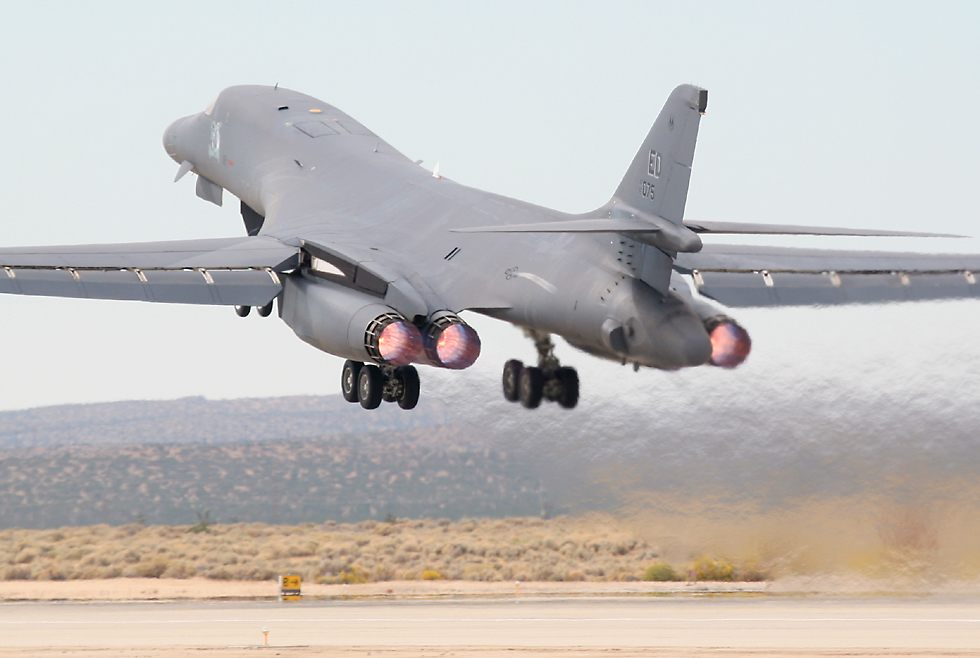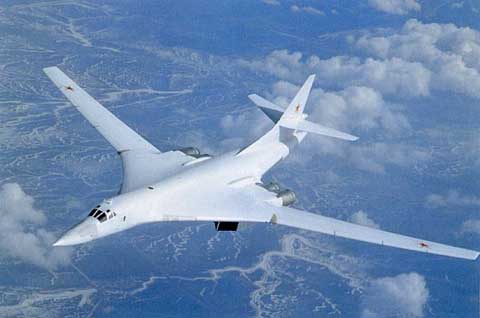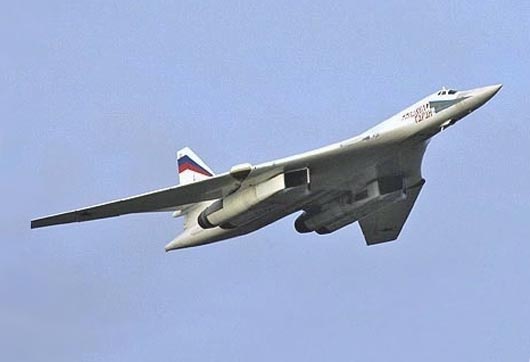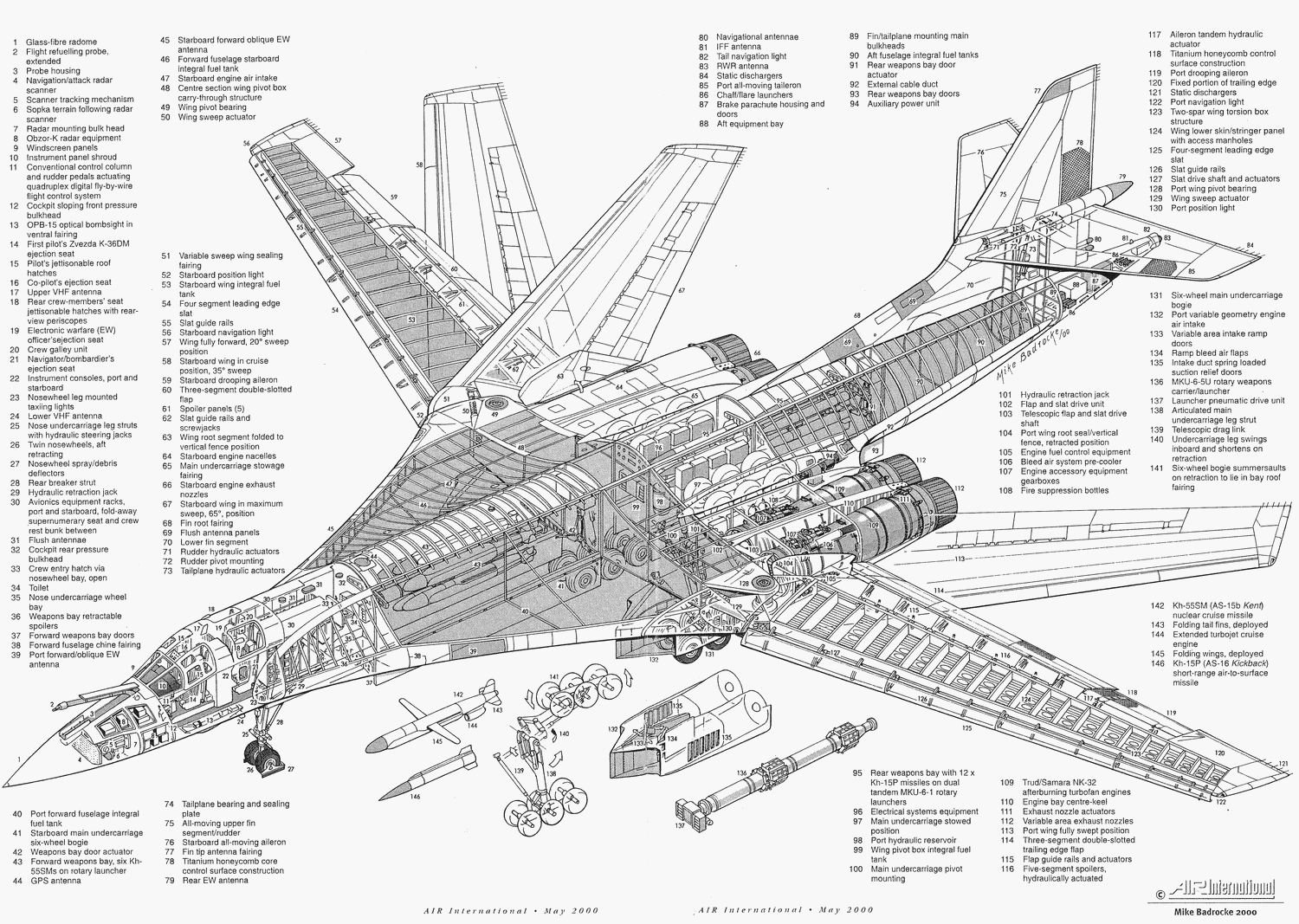Supersonic Bombers-The Rockwell B-1 Lancer & Tupolev Tu-160
The Rockwell B-1 Lancer





The B-1 has a blended wing body configuration, with variable-sweep wing, four turbofan engines, and triangular fin control surfaces. The wings can sweep from 15 degrees to 67.5 degrees (full forward to full sweep). Forward-swept wing settings are used for takeoff, landings and high-altitude maximumcruise. Aft-swept wing settings are used in high subsonic and supersonic flight. The wings of the B-1B originally were cleared for use at settings of 15, 25, 55 and 67.5 degrees. The 45-degree setting was later cleared in 1998–99 timeframe.
The B-1's variable-sweep wings and thrust-to-weight ratio provide it with better takeoff performance, allowing it to use more runways than previous bombers.The length of the aircraft presented a flexing problem due to air turbulence at low altitude. To alleviate this, Rockwell included small triangular fin control surfaces or vanes near the nose on the B-1. The B-1's Structural Mode Control System rotates the vanes automatically to counteract turbulence and smooth out the ride.
Unlike the B-1A, the B-1B made no attempt at Mach 2+ speeds. Its maximum speed is Mach 1.25 (about 950 mph or 1,530 km/h at altitude),but its low-level speed increased to Mach 0.92 (700 mph, 1,130 km/h).Technically, the current version of the aircraft can exceed its speed restriction, but not without risking potential damage to its structure and air intakes. To help lower its radar cross section (RCS), the B-1B uses serpentine air intake ducts and fixed intake ramps, which limit its speed.Vanes in the intake ducts serve to deflect and shield radar emissions from the highly reflective engine compressor blades.
- Crew: 4 (aircraft commander, copilot, offensive systems officer and defensive systems officer)
- Payload: 125,000 lb (56,700 kg) ; internal and external ordnance combined
- Length: 146 ft (44.5 m)
- Wingspan:
- Extended: 137 ft (41.8 m)
- Swept: 79 ft (24.1 m)
- Height: 34 ft (10.4 m)
- Wing area: 1,950 ft² (181.2 m²)
- Airfoil: NA69-190-2
- Empty weight: 192,000 lb (87,100 kg)
- Loaded weight: 326,000 lb (148,000 kg)
- Max. takeoff weight: 477,000 lb (216,400 kg)
- Powerplant: 4 × General Electric F101-GE-102 augmented turbofans
- Dry thrust: 14,600 lbf (64.9 kN) each
- Thrust with afterburner: 30,780 lbf (136.92 kN) each
- Fuel capacity, optional: 10,000 U.S. gal (38,000 L) fuel tank for 1–3 internal weapons bays each
Performance
- Maximum speed:
- At altitude: Mach 1.25 (721 knots, 830 mph, 1,340 km/h at 50,000 ft/15,000 m altitude)
- At low level: Mach 0.92 (700 mph, 1,130 km/h at 200–500 ft/60-150 m altitude)
- Range: 6,478 nmi (7,456 mi, 11,998 km)
- Combat radius: 2,993 nmi (3,445 mi, 5,543 km)
- Service ceiling: 60,000 ft (18,000 m)
- Wing loading: 167 lb/ft² (816 kg/m²)
- Thrust/weight: 0.38
Tupolev Tu-160





The Tupolev Tu-160 (Russian: Туполев Ту-160, NATO reporting name: Blackjack) is a supersonic, variable-sweep wing heavy strategic bomber designed by the Tupolev Design Bureau in the Soviet Union. Although several civil and military transport aircraft are larger in overall dimensions, the Tu-160 is currently the world's largest combat aircraft, largest supersonic aircraft, and largest variable-sweep aircraft built. The aircraft remains in limited production, with at least 16 aircraft currently in service with the Russian Air Force.
The Tu-160 is a variable-geometry wing aircraft, with sweep selectable from 20° to 65°. The aircraft employs a fly-by-wire control system with a blended wing profile and full-span slats are used on the leading edges, with double-slotted flaps on the trailing edges. The variable geometry gives conventional takeoff, and efficient subsonic cruise, while also permitting Mach 2 flight.
The Tu-160 is powered by four Kuznetsov NK-321 afterburning turbofan engines, the most powerful ever fitted to a combat aircraft. Unlike the AmericanB-1B Lancer, which reduced the original Mach 2+ requirement for the B-1A to achieve a smaller radar profile, the Tu-160 retains variable intakes, and is capable of reaching Mach 2 speed at altitude. The NK-321 turbofans are efficient for subsonic cruise, but suboptimal for supersonic flight due to inlet drag.
While similar in appearance to the American B-1 Lancer, the Tu-160 is a different class of combat aircraft, its primary role being a standoff missile platform (strategic missile carrier). The Tu-160 is also larger and faster than the B-1B and has a slightly greater combat range, though the B-1B has a larger combined payload.Another significant difference is that the colour scheme on the B-1B Lancer is usually radar-absorbent black, the Tu-160 is painted with anti-flash white, giving it the nickname among Russian airmen "White Swan"
General characteristics
- Crew: 4 (pilot, co-pilot, bombardier, defensive systems operator)
- Length: 54.10 m (177 ft 6 in)
- Wingspan:
- Spread (20° sweep): 55.70 m (189 ft 9 in)
- Swept (65° sweep): 35.60 m (116 ft 9¾ in)
- Height: 13.10 m (43 ft 0 in)
- Wing area:
- Spread: 400 m² (4,306 ft²)
- Swept: 360 m² (3,875 ft²)
- Empty weight: 110,000 kg (242,505 lb)
- Loaded weight: 267,600 kg (589,950 lb)
- Max. takeoff weight: 275,000 kg (606,260 lb)
- Powerplant: 4 × Samara NK-321 turbofans
- Dry thrust: 137.3 kN (30,865 lbf) each
- Thrust with afterburner: 245 kN (55,115 lbf) each
Performance
- Maximum speed: Mach 2.05 (2,220 km/h, 1,200 knots, 1,380 mph) at 12,200 m (40,000 ft)
- Cruise speed: Mach 0.9 (960 km/h, 518 knots, 596 mph)
- Range: 12,300 km (7,643 mi) practical range without in-flight refuelling, Mach 0.77 and carrying 6 × Kh-55SM dropped at mid range and 5% fuel reserves
- Combat radius: 7,300 km (3,994 nmi, 4,536 mi,) 2,000 km (1,080 nmi, 1,240 mi) at Mach 1.5
- Service ceiling: 15,000 m (49,200 ft)
- Rate of climb: 70 m/s (13,860 ft/min)
- Wing loading: 742 kg/m² with wings fully swept (152 lb/ft²)
- lift-to-drag: 18.5-19, while supersonic it is above 6.
- Thrust/weight: 0.37
Comments
Post a Comment